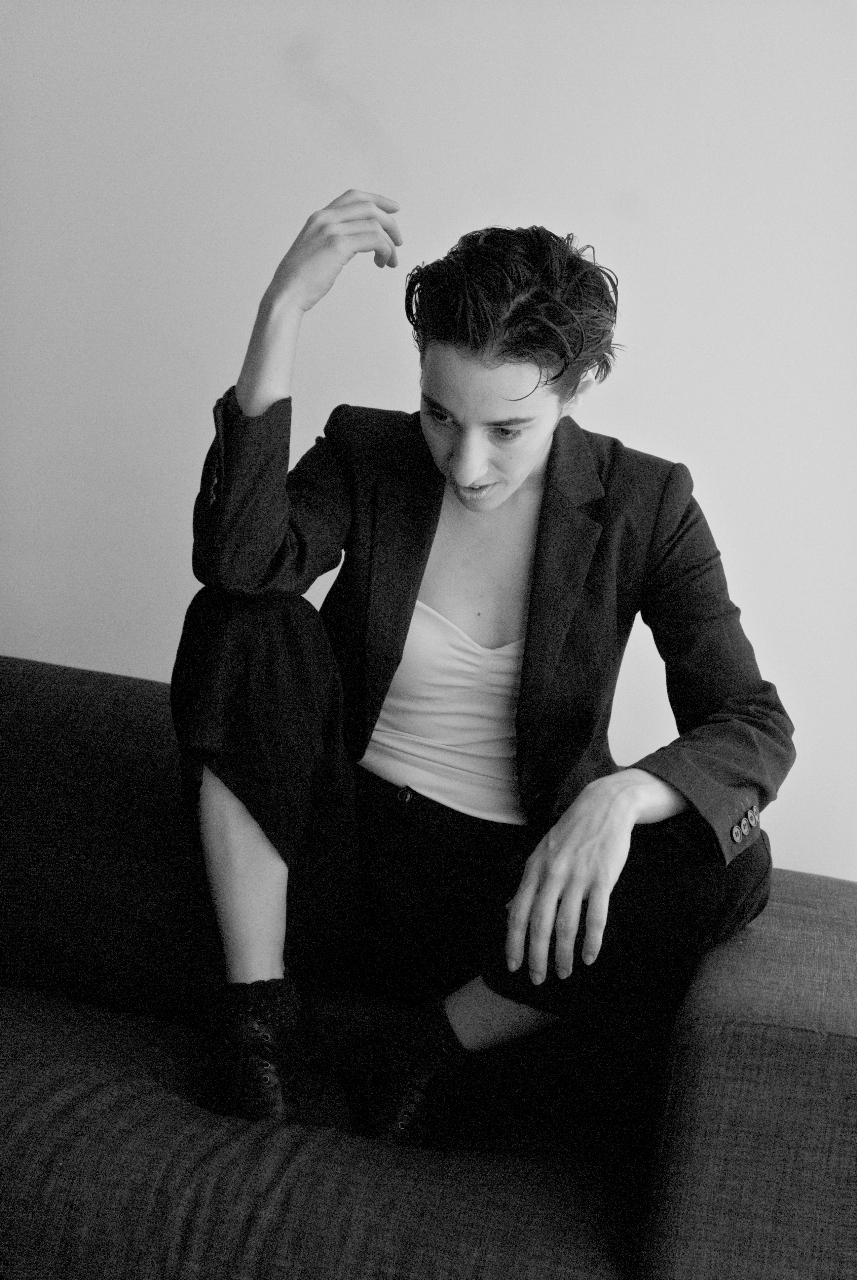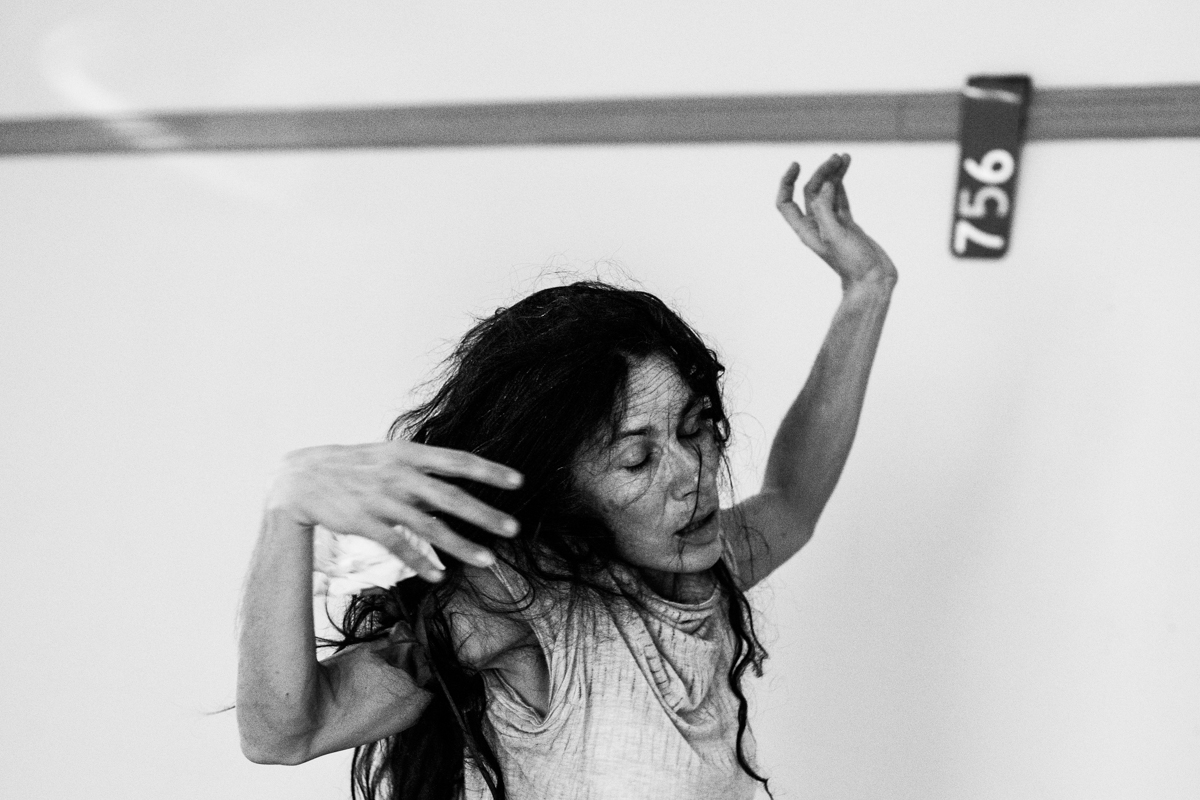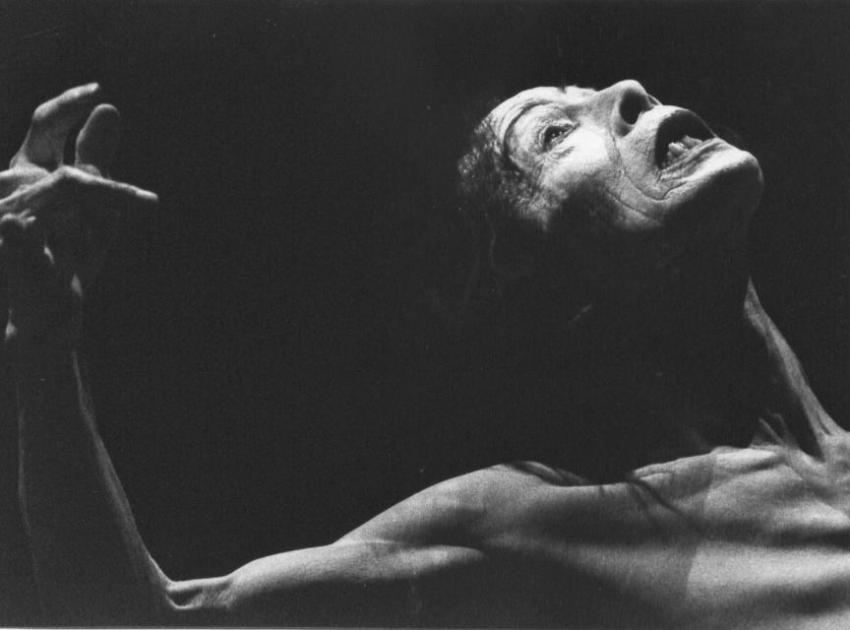Originally known only as the “dance of darkness” or “dance of death”, Butoh has evolved into an encompassing expression of every element to be found through the human body. It does not transcend the human form or express a superhuman consciousness, but challenges us to comprehend ourselves through a different mentality. Despite the fairly recent origination of this dance form, it has quickly appealed and demonstrated that it speaks to something common within us, however we may allow our cultural and geographic borders to define us.
A Background on Butoh
Kazuo Ohno © H. Tsukamoto
Dance is a corporeal poetry that speaks to us through sensual body memory and intangible thought, thus communicating experience and expressing ideals. We may, for instance, find the most exquisite aspirations to perfection in the sculptural forms of ballet and the etiquettes of ballroom dance — but what dance is there to speak of anguish and terror? What of the uncontainable spirit that seeps from our grotesque beings in spite of vigilant taboo? Would it not be deceptive to express the most visceral of human experience through only forms of chiseled beauty?
Dance that declares itself as an encompassing language for human experience yet speaks from under a veneer of piety for conventional aesthetics is fundamentally dishonest. With passionate protest to the void in integrity of expression and against standards of superficiality, Butoh emerged at the end of the 20th century.
It was in the shadow of the nuclear bombings of Hiroshima and Nagasaki that Butoh’s first breaths were drawn, already shuddering naked and borne by true darkness. Shaped into its ghostly form by dancers Kazuo Ohno and Tatsumi Hijikata, Butoh came to define Japanese avant-garde dance in its embrace of the totality of emotional experience and the absurdity found in the raw body. Ohno and Hijikata composed a new lyric for the human body where nothing was forbidden to experience. The revolutionary spirit of Butoh explored morbidity and sexuality in its most explicit forms. By doing so, it not only transformed the Japanese stage but connected with international audiences and dancers, tantalizing a universal desire for this same purity of expression. Until the ’60s, there had been no such dance within Japan that allowed for the communication of the uninhibited body and, as far as technical form, there still exist few such parallels.
Kazuo Ohno & Tatsumi Hijikata
As Butoh has grown in popularity, its essence has evolved into as many forms as there are dancers.
“In general,” says Katsura Kan, a Kyoto-based Butoh dancer and choreographer, “if we have five Butoh dancers, we have six different philosophies.”
Despite this fluidity, there remain some elements that unify familiar aesthetics and practices within Butoh. In a celebration of the unmediated experience, Butoh often disregards the use of particular choreography. Themes of the absurd, tragic and grotesque continue to dominate, although this has increasingly evolved as dancers accept the anti-aesthetic essence of Butoh form. Butoh invites unlimited possibility for exploration of self and of environment. The continued progress made in sharing this revolutionary dance is sure to open a greater medium of expression and of engaging with every aspect of our realities.
Highlight Question
What are some of the most important differences and challenges in adapting Butoh around the world? How do you think Butoh will change to become more relevant to a younger generation, and adapt across cultures?
“Butoh needs more time, and let’s see the future as a new vocabulary to discover the human that you are.” – Katsura Kan (Kyoto-based Butoh dancer, Director of “Katsura Kan & Saltimbanques”)
“The seed of Butoh is flowing all over the world and a lot of different flowers are growing – Butoh flowers – but I don’t know how Butoh will develop.” – Tadashi Endo (Göttingen-based Butoh dancer, Director of Butoh-Center MAMU and Butoh-Festivals MAMU)
“I think the most important way to adapt Butoh around the world is to stop constraining our Japanese way to foreigners […] The definition of Butoh is just “a step from within”: this concept is very simple — out of [the] Japanese way, more universal way — [a] so everybody can try it around the world.” – Tetsuro Fukuhara (Tokyo-based Butoh dancer, Director of Tokyo Space Dance)
“I think it’s extremely important to always refer back to Hijikata, Ohno, Tanaka and Kasai, and Nakajima. If we lose the original drives and aspirations completely, then we will also dilute and destroy the original promise of Butoh. It has to be radical, alive, relevant, and this is the power for a younger generation.” – Marie-Gabrielle Rotie (London-based Butoh dancer, Butoh workshop director)
Butoh Dancer Spotlight: Florencia Guerberof (Argentina/U.K.)
 “I come from Buenos Aires, Argentina. I was exposed to dance, theater and cinema since my childhood. My parents worked in the theater, so the theater where they used to work was like my second home… I was fascinated by the Lindsay Kemp company. I also remember Moses Pendleton (creator of the MOMIX company). My mother took me to see many incredible performances by the Argentinean choreographer Oscar Araiz and the wonderful French artist Jean Francois Casanovas. I was also struck by Laurie Anderson‘s work: her strength and manly appearance. Peter Brook’s play Peter Brook’s play The Man Who… based on clinical tales by Oliver Sacks, The Man Who Mistook His Wife For A Hat (1985).
“I come from Buenos Aires, Argentina. I was exposed to dance, theater and cinema since my childhood. My parents worked in the theater, so the theater where they used to work was like my second home… I was fascinated by the Lindsay Kemp company. I also remember Moses Pendleton (creator of the MOMIX company). My mother took me to see many incredible performances by the Argentinean choreographer Oscar Araiz and the wonderful French artist Jean Francois Casanovas. I was also struck by Laurie Anderson‘s work: her strength and manly appearance. Peter Brook’s play Peter Brook’s play The Man Who… based on clinical tales by Oliver Sacks, The Man Who Mistook His Wife For A Hat (1985).
In 2011, I created a piece called My Hometown Is In My Shoes. This dance theater work focuses mainly on the feet. The shoes are seen as a home, and this responds to my condition as a foreigner living abroad for many years, not grounded or rooted to any particular place.
I always try to make work using very basic means. My aim is to be able to create something powerful out of very simple and immediate things. This idea comes from my origin.
I studied art in Argentina… I remember with admiration how the art students in Buenos Aires used to make amazing work out of nothing. They worked with very basic means, as we didn’t count with high technology and all the facilities, but with brilliant minds. The lack of resources makes you more creative. This is what has influenced me the most about my country.”








[…] Butoh Dancing (舞踏): Discovering Emptiness, Embodiment & Environment in an Archeology of Body: http://www.redefinemag.com/2013/international-butoh-dancing-emptiness-embodiment-environment-archeol… […]
Hi Yan, Thank you so much for your kind words 🙂 Glad you enjoyed the article!
Even if I was not honored to be interviewed by you in this article, I would still be very impressed with your research and perspective Lital. Thank you for your careful and thorough attention to this important art of our times. Hopefully it will inspire people to attend a performance or workshop themselves as that is really the definitive way for this art to be experienced — directly through the body in real time + space.
[…] ARTICLE: BUTOH DANCING (舞踏): DISCOVERING EMPTINESS, EMBODIMENT & ENVIRONMENT IN AN ARCHAEOLOGY OF BOD… // Redefine […]
[…] Discovering Emptiness, Embodiment & Environment in an Archeology of Body’. Available at: http://www.redefinemag.com/2013/international-butoh-dancing-emptiness-embodiment-environment-archeol… (Accessed: 12 June […]